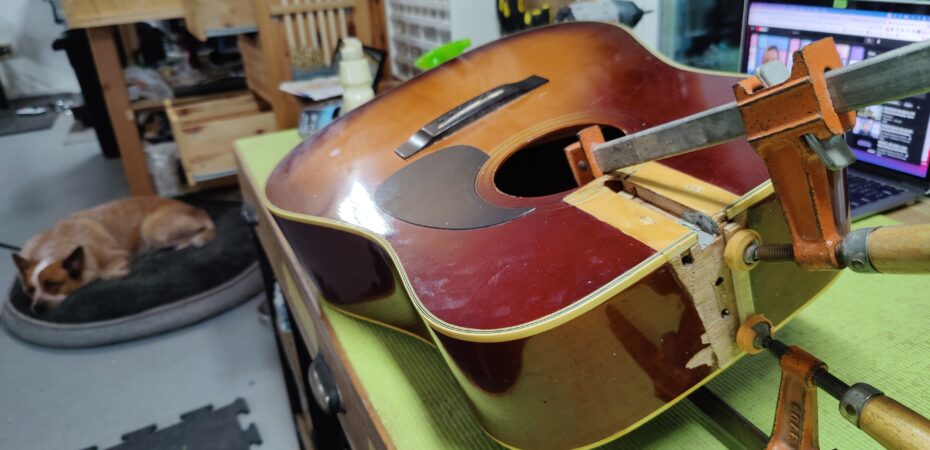Goya Acoustic Bolt on Conversion
South Austin Guitar Repair
Originally a Swedish manufactured instrument, Goya was acquired by Martin Guitars in the late 1970’s. Soon after, they re-purposed the brand for Japanese and Korean manufacturing with the intent of selling the brand at a lower price point globally.
With lower price points comes cost cutting measures and wow, did they find a cheaper way to manufacture an acoustic… Actually, this method had been in place for several decades in Japan, according to other instruments that have come across my bench over the years. It was more surprising to see this construction in use as late as this guitar was made (Somewhere in the 1980s-1990s). That method, is attach the neck to the body with several wood dowels, glue the fingerboard to the body and hope for the best.
I can envision a nascent guitar manifesting industry in post WW2 Japan. They wanted to create, they wanted to emulate, they wanted to innovate. But due to a lack of modern guitars available in Japan, it was difficult to reverse engineer what they saw. There were no guitar manufacturers within the country for a few hundred years like Spain, France or the USA had. At best, they may have recovered one from a bombed military base in a random island somewhere in the Pacific. So, they did the best they could. They likely consulted a traditional woodworker (or not?) in an attempt to finalize their guitar’s design. And that, bring us to the most unstable way to construct an acoustic neck joint.
It’s only a matter of time until something happens with an acoustic like this. The old glue can deteriorate or heat up enough to cause the neck to cave in. The pressure of the strings will cause the neck and body to implode eventually. In this case, as many cases, the guitar took a fall. Upon hitting the ground, the tension of the strings pulled on a weak neck joint with old, brittle glue and the guitar broke into a few pieces. In addition to the neck breaking from the body, the fingerboard extension snapped clean off as well.
Fortunately, with the wide distribution of these imported guitars over decades, and the same issues built into each, there’s a known fix. Convert the acoustic, to a bolt on construction, like a Taylor.
I’m kicking myself for not taking more pictures of this process. I actually performed this repair over a year ago and the pictures have been sitting this whole time waiting for me to find some free time. Which is me currently sitting on my laptop on vacation at midnight.
The neck joint break had a several issues to correct first. The laminate/spruce top had warped upon the neck pulling off. The side wall of the body had pulled away from the neck block and needed to be re-glued. The binding had fragmented off where the neck met the body. The truss rod channel had some gnarly hardened epoxy residue and the finish had ripped out a few pieces upon the break.
The neck’s fingerboard extension had some nice angular wood fibers that married back together nicely where it initially broke. Once that was back together, I fit the neck to the body to see what was needed next. The warped top needed attention next. I created a makeshift routing template and glided my palm router with a wide surfacing bit to equalize the wood surface. Success.
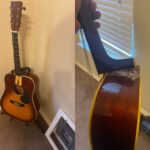
| 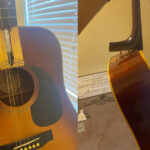 |
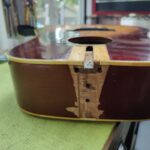 |
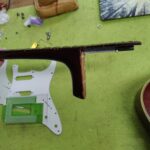 |
I again held the neck back in place on the body and everything was aligning well. I then drilled out two of the center dowel holes in the neck’s faux dovetail joint to accommodate threaded inserts for the bold on conversion. After that, I drilled out the old corresponding dowel holes within the body/neck block to allow the 1/4″ screws to bolt the neck in place.
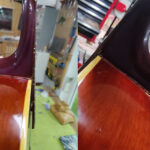
| 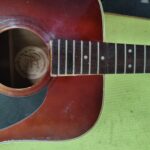 |
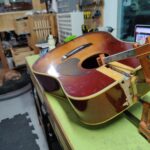 |
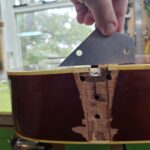 |
The last step before attaching the neck back to the body was what to do about the broken finish at the neck joint. The customer was not particular with the cover up, so I lightly sanded the rough edges of the break, masked off the rest of the body and sprayed a layer of Red Mahogany, followed by a layer of Tobacco Brown. I repeated that process twice and finished off the area with a few clear coats.
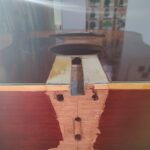
| 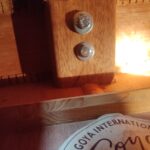 |
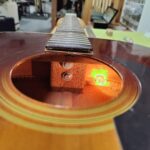 |
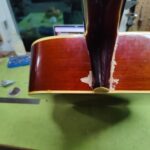 |
I applied some wood glue to the underside of the fingerboard extension and clamped it against the body after bolting the neck joint back together. The guitar’s action maintained a very playable angle after the neck joint corrections were made, so no shims were necessary in the joint and this guitar is back to playing better than before.
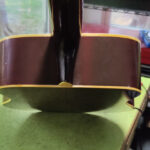 |
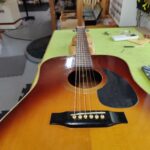 |
For all your oddball acoustic repairs, call Andrew with South Austin Guitar Repair (512) 590-1225.
